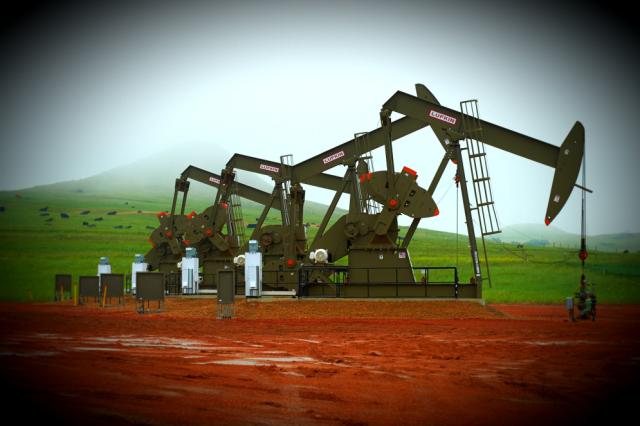
Pumpjacks above oil wells in the Bakken Formation in North Dakota. (Source: Stephen Collector/Hart Energy)
Almost a decade ago, Clint Hacker traded the Arizona sunshine for the sub-zero temperatures of the North Dakota winter, migrating north along with thousands of others to join in a modern-day gold rush as oil production boomed in the Bakken shale.
This year, he was forced to lay off two-thirds of workers at his oilfield services company as the COVID-19 pandemic pushed the state’s oil sector into a downturn unprecedented in both speed and magnitude.
“I think it’s probably the worst times the Bakken has seen—or maybe that the oil and gas industry, in general, has seen,” said Hacker, now CEO of Nodak Oilfield Services.
The price crash triggered by the pandemic has been brutal for the oil industry across the US, but nowhere more so than North Dakota. Here, the explosive growth of the Bakken—the first big oil field to emerge during the shale revolution—has placed the sector at the heart of the state’s economy.
Now, as North Dakota emerges from the downturn, the oil industry’s prospects seem far less certain. Investment has dried up, political support is waning, and the future of a key pipeline transporting crude from the state hangs in the balance.
This year’s pain arrived quickly. North Dakota entered 2020 at record production levels. Output was second only to Texas as it pumped out almost 1.5 million bbl/d of oil, or 12% of the nation’s total. “March changed everything,” said Lynn Helms, director of the North Dakota department of mineral resources (DMR).
That was when a Saudi-Russian crude price war erupted and stay-at-home orders imposed across the country to stem the spread of COVID forced cars off the roads and grounded planes, crippling oil demand. U.S. oil traded in negative territory for the first time.
North Dakota operators shut almost a quarter of their wells, four in five rigs were laid down and production slid 40%. By most metrics, Helms said, “the numbers for 2020 are the worst they’ve ever been.”
“Industry was essentially brought to a standstill in the first 45 days of COVID,” said Ron Ness, president of the North Dakota Petroleum Council. Operators slashed capital expenditure and work dried up for service providers. Whiting Petroleum Corp., one of the Bakken’s largest producers, was the first big-name nationally to file for bankruptcy.
North Dakota is no stranger to commodity cycles. The 2014 downturn hit it hard, sending much of its migrant workforce packing. But this year’s crash is different. Not only was it swifter and more brutal than any in the state’s history, but it comes as the industry to which the state has tethered its fortunes comes under fire from all angles.
The shale patch was already struggling to attract investment ahead of this year’s crash, as Wall Street tired of its profligacy and poor returns. Now environmental concerns are making it less appealing still. What money there is has tended to be directed towards the Permian basin of Texas and New Mexico, viewed by an increasing number of companies as having the best growth potential.
Meanwhile, Joe Biden, America’s president-elect, has vowed to “transition from the oil industry” and to ban new drilling on federal lands—on which one-third of North Dakota’s well pads sit.
Things may get worse. The future of the Dakota Access Pipeline, the primary route by which oil exits the state, hangs in the balance. It was almost shut down by a federal judge this year after he found the Trump administration had rushed through a key environmental permit. Its closure, sought by activists and indigenous groups, would force much of the state’s oil exports on to expensive rail cars, driving up the price needed for producers to return to drilling by another $7 to $60-$65/bbl, according to the DMR, a level well above average prices this year.
Kamala Harris, Biden’s vice-president-elect, has voiced support for shutting the pipeline. And Deb Haaland, the president-elect’s pick for interior secretary, whose department is responsible for infrastructure permitting, attended protests against it, cooking green chilli and tortillas for demonstrators.
As troubles mount for the sector there have been fresh calls to diversify the state’s economy away from its reliance on “soil and oil.”
“The energy industry, specifically talking about oil and gas development, has become foundational to our state’s economy,” said David Ripplinger, an economics professor at North Dakota State University. Efforts to diversify have been present for years, but they might now rise up the agenda, he said.
“I think that there’s certainly concerns about medium and long-term petroleum use,” Ripplinger said. “If oil use levels off and then starts to decline we’re kind of in a spot.”
The state’s difficulties stand in contrast to the booming growth of the past decade. Between 2009 and the beginning of 2020 oil production in North Dakota rocketed from less than 200,000 bbl/d to almost 1.5 million bbl/d. Oil and gas became its biggest industry, supplying more than half of the state’s general fund revenue.
The boom triggered an influx of workers from across the country like Hacker as Americans left out of work in the wake of the financial crisis downed tools and headed north in search of better lives. After seven decades of decline, North Dakota’s population climbed to record levels, flipping it from being the state with the highest proportion of seniors to the highest proportion of millennials.
“It was just a different place, a different world,” Hacker said.
Those days seem like a distant memory. But there is optimism that despite the challenges, the sector has another recovery in it.
“We’re going to rebound,” said Ness of the North Dakota Petroleum Council. “It’s going to be dependent upon the price and the investment, but certainly the Bakken is a world class resource and there’s still a tremendous amount to garner from it.”
Production has begun to climb again as the Bakken’s inventory of “drilled but uncompleted” wells are brought online, supported by federal grants. But with minimal new drilling being carried out, output will slide next year. Only a significant oil price rise will see operators deploy many new rigs again.
When growth does return, according to the DMR, it will be at a much slower pace, edging upwards to reach a peak of 2 million bbl/d by 2035.
“We’re striving for a more sustainable slower growth rate, where the infrastructure keeps up,” said Helms of the state’s department of mineral resources. “The high-profile glory days of extreme, rapid growth are behind us.”
Recommended Reading
Defeating the ‘Four Horseman’ of Flow Assurance
2024-04-18 - Service companies combine processes and techniques to mitigate the impact of paraffin, asphaltenes, hydrates and scale on production — and keep the cash flowing.
Tech Trends: AI Increasing Data Center Demand for Energy
2024-04-16 - In this month’s Tech Trends, new technologies equipped with artificial intelligence take the forefront, as they assist with safety and seismic fault detection. Also, independent contractor Stena Drilling begins upgrades for their Evolution drillship.
AVEVA: Immersive Tech, Augmented Reality and What’s New in the Cloud
2024-04-15 - Rob McGreevy, AVEVA’s chief product officer, talks about technology advancements that give employees on the job training without any of the risks.
Lift-off: How AI is Boosting Field and Employee Productivity
2024-04-12 - From data extraction to well optimization, the oil and gas industry embraces AI.
AI Poised to Break Out of its Oilfield Niche
2024-04-11 - At the AI in Oil & Gas Conference in Houston, experts talked up the benefits artificial intelligence can provide to the downstream, midstream and upstream sectors, while assuring the audience humans will still run the show.





